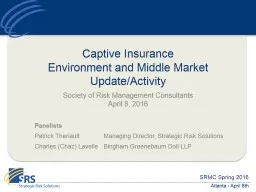PPT-The Real Deal on Captives
Author : alida-meadow | Published Date : 2016-02-27
Superintendent Joe Torti III RI SystemicStability Concerns Pt 1 Federal agencies and the media have expressed potential systemicstability concerns with captive
Presentation Embed Code
Download Presentation
Download Presentation The PPT/PDF document "The Real Deal on Captives" is the property of its rightful owner. Permission is granted to download and print the materials on this website for personal, non-commercial use only, and to display it on your personal computer provided you do not modify the materials and that you retain all copyright notices contained in the materials. By downloading content from our website, you accept the terms of this agreement.
The Real Deal on Captives: Transcript
Download Rules Of Document
"The Real Deal on Captives"The content belongs to its owner. You may download and print it for personal use, without modification, and keep all copyright notices. By downloading, you agree to these terms.
Related Documents














